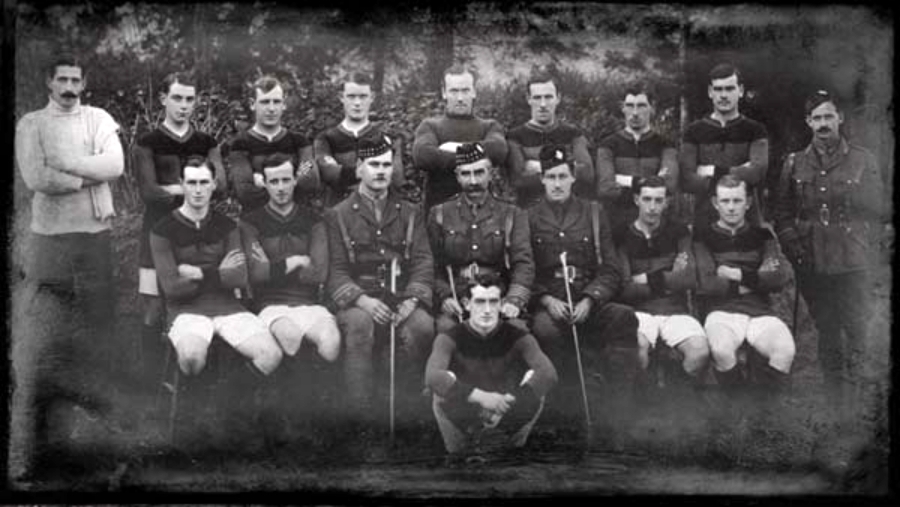Over the last eleven years, shared research has found thirty-one former players to have been killed during the two world wars who are now remembered by Brentford FC.
A new name can now be added to the Remembrance Plaque on the West Stand of the Gtech after further research.
JAMES (JIMMY) BOYD
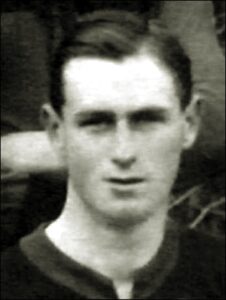 James Boyd was a Scottish footballer, born on 14 November 1894 in Seafield (Livingston) Linlithgowshire (West Lothian) Scotland.
James Boyd was a Scottish footballer, born on 14 November 1894 in Seafield (Livingston) Linlithgowshire (West Lothian) Scotland.
The 1901 and 1911 Census records of Scotland note the Boyd family living at Front Street in West Calder, Midlothian. His father, also James, was a shale hewer (a shale miner) and his mother, Jane, looked after their two sons and two daughters. James and Jane also had two older daughters who had left home by 1911.
After being educated at West Calder Public School James became an underground worker in the shale mines, like his father.
Boyd began in Scottish Junior football playing as a centre-forward with Mossend Burnvale FC, in the West Calder League. At Burnvale, he played alongside his brother Archie, a goalkeeper. Boyd was also a noted cricketer, also with Archie, for Burnvale CC during the summer months.
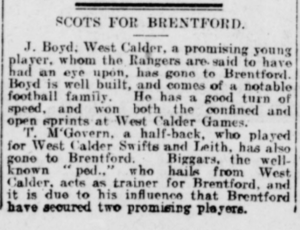
Daily Record 19 August 1913
James came on trial to Brentford on the recommendation of the Brentford trainer, William Biggar, who had also requested the trial of Tom McGovern, who went on to serve Brentford for several years.
James first appeared in a pre-season practice/trial match on Monday 18 August.
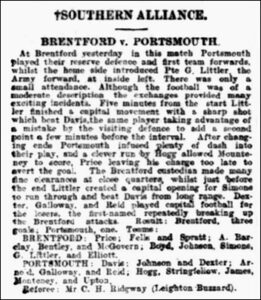
The Sportsman 09 September 1913
Then debuting for Brentford Reserves on Saturday 6 September versus Croydon Common reserves, scoring in a three one victory.
Boyd then appeared in his only first eleven fixture versus Portsmouth in the Southern Alliance on Monday 8 September 1913. In this fixture it is noted,
Boyd appeared to play well and assisted in one of the three goals scored by Brentford.
Boyd was then mentioned in a local newspaper that he would appear for the Brentford Reserve XI versus a South West Middlesex League Representative XI, at Griffin Park. However, a match report doesn’t mention that he played. Although, it also doesn’t list the eleven who did! Brentford won seven nil.
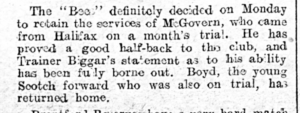
Chiswick Times 19 September 1913
The next mention is in a snippet from the Chiswick Times on 19 September 1913 that Boyd wasn’t kept on after his trial, although McGovern was, on the advice of Biggar.
Boyd returned to Scotland and his home town Club, West Calder Swifts FC.
His brother Archie had already left West Calder to appear for Bo’ness FC. For the first few months of 1914, James followed Archie and appeared for the Bo’ness. During the Summer of 1914, James and Archie both signed for Heart of Midlothian FC. Archie played for the first team while James appeared in the reserves.
James Boyd, following in the footsteps of many other Hearts footballers, enlisted into the 16th Battalion Royal Scots in Edinburgh, on 8 December 1914, as Private 18976. The 16th Battalion of the Royal Scots would become known as “McCrae’s Battalion”.
[More information on this Battalion is available here; http://www.mccraesbattaliontrust.org.uk/]
James’ time in the Royal Scot’s can be followed in the Battalion’s War Diary and the above link. The Battle of the Somme has become notorious for the actions of many Battalions and the sad loss of many soldiers from 1 July 1916 to 18 November 1916.
It was during these series of battles on the Somme that James Boyd was to lose his life.
Near to High Wood, an area to the east of Bazentin-Le-Petit, was where James Boyd’s body was later found, outside of the trench. He was, more than likely, part of the bombing raid/attack that took place on the night of 1 August 1916 and into 2 August 1916 before finally gaining the Battalion’s objective on 3 August 1916.
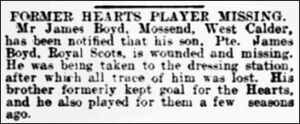
West Lothian Courier 29 September 1916
Seen to be wounded by others within the ranks, who were likely mistaken, James was noted as wounded/missing on three occasions.
On 26 August 1916 “wounded”. On 22 September 1916 “wounded/missing”. Lastly, on 28 February 1917, “missing”.
Sadly, unable to return to the trenches and therefore unable to receive the assistance he desperately required, James Boyd subsequently died of his wounds in ‘no man’s land’. James’ death is noted in official records as Killed in Action on or since 3 August 1916. His body was later found by Sgt. J Fuge 3038 of 8th Bn. Durham Light Infantry.
A statement by Sgt. Fuge states:
“…..Towards the end of September 1916, I was in charge of a burying party and found Private Boyd lying dead outside a trench in the vicinity of High Wood. I took his identity disc and pay book, both of which bore his name and reg. number. Following my orders, I bundled the lot together and handed them to casualty officer 2/Lt. Twigg of the 8th D.L.I. I hear by swear on my honour I saw Pte Boyd was killed, and I saw him buried.
(Signed) Sgt Fuge J.”
Unfortunately, Sgt J Fuge never states the co-ordinates as to where Pte. Boyd’s body was buried. If he did, then we could place an approximate area as to where he was laid to rest. Sadly, as with many bodies buried in a rush during WW1, James’ body was lost to the earth and was never recovered after the War.
This extract from Hearts at Wat 1914-1919 is worth noting.
Hearts at War 1914-1919
By Tom Purdie Amberley Publishing Limited (Aug 2014)
“When the Boyd brothers’ mother heard their intentions that evening when they returned to their house in Mossend, West Calder, she was shocked. Mrs Boyd declared that she would only allow one of her sons to join up as someone had to remain at home to support the family. The truth of the matter was that it would be bad enough losing one of her boys to the war; two would be unthinkable. Mrs Boyd, with tears in her eyes, left the two brothers alone in the room to make the decision as to which one of them would be left behind. The brothers looked at each other as they tried to come to terms with what their mother had said. Young Jimmy made the decision. Archie was engaged to be married and had more to lose.
Mrs Boyd accepted Jimmy’s unselfish act with a heavy heart, as did Archie. The scenario in the Boyd household must have been much the same in other homes when the other players had broken the news to their respective families. A lot of tears would have been shed in houses in and around the city of Edinburgh. Paddy and Jimmy put pen to paper two days later. The Heart of Midlothian football club had given Sir George two more of their family…..”
Private James Boyd 18976 is remembered on the Thiepval Memorial, Department de la Somme, Picardie, France. Pier and Face 6 D and 7 D and is also remembered on the West Calder War Memorial Harburn Road West Calder Scotland.
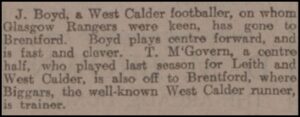
Dundee Evening Telegraph 03 September 1913
Boyd reported to have joined Brentford FC
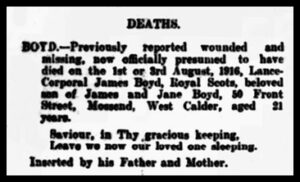
Midlothian Advertiser 18 May 1917
Boyd’s death reported
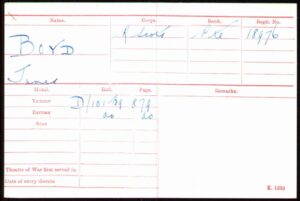
Boyd’s Medal Index Card
Paul Briers
WE WILL REMEMBER THEM

